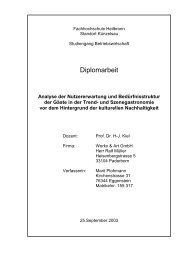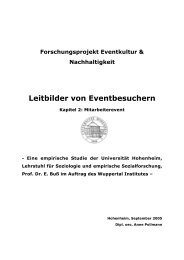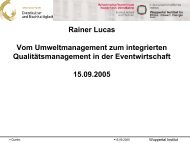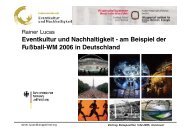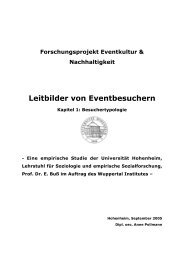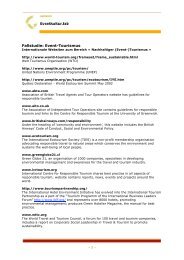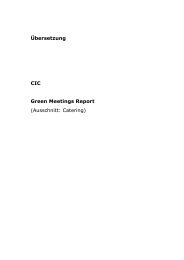environmental management and monitoring for ... - Eventkultur.lab
environmental management and monitoring for ... - Eventkultur.lab
environmental management and monitoring for ... - Eventkultur.lab
You also want an ePaper? Increase the reach of your titles
YUMPU automatically turns print PDFs into web optimized ePapers that Google loves.
Selecting Appropriate Indicators<br />
EPIs can be put to practical use by event organisers <strong>and</strong> facility operators <strong>for</strong><br />
<strong>monitoring</strong> specific issues. The in<strong>for</strong>mation gleaned can help to:<br />
• prioritise <strong>and</strong> direct improvement ef<strong>for</strong>ts;<br />
• track resource consumption over time;<br />
• track <strong>environmental</strong> per<strong>for</strong>mance <strong>and</strong> improvements over time;<br />
• assess the impact of new practices <strong>and</strong> investments;<br />
• compare the per<strong>for</strong>mance of one event to another through<br />
benchmarking; <strong>and</strong>,<br />
• evaluate health-related <strong>environmental</strong> conditions <strong>and</strong> use this to select<br />
dates <strong>and</strong> locations.<br />
Because each user group will have its own set of priorities, it is not useful to<br />
propose a universal list of the most important indicators. Rather, each user<br />
will need to review the list of potential EPIs (see Appendix B) to select those<br />
that are most useful in meeting his/her goals <strong>and</strong> objectives. Factors that will<br />
influence that decision might include; regional pollution concerns, goals <strong>and</strong><br />
objectives of the managing bodies, concerns of stakeholders, avai<strong>lab</strong>ility of<br />
data, <strong>and</strong> the cost (if any) of obtaining that data.<br />
The following diagram illustrates a process <strong>for</strong> selecting appropriate EPIs:<br />
Selecting EPI's<br />
1. Review goals <strong>and</strong> objectives of event or facility<br />
2. Identify local issues <strong>and</strong> stakeholder concerns<br />
3. Develop a tentative list of potential indicators<br />
4. Determine avai<strong>lab</strong>ility of indicators <strong>and</strong> costs of<br />
measurement<br />
5. Select indicators <strong>and</strong> identify collection plan<br />
6. Monitor <strong>and</strong> manage results<br />
7. Report results when appropriate<br />
8. Review indicators, modify if necessary by returning to step 1<br />
The process may be followed just once in the case of a once-only event, or<br />
repeated <strong>for</strong> regular events or permanent facilities which monitor indicators<br />
over time.<br />
Managing <strong>and</strong> Monitoring Environmental Per<strong>for</strong>mance of Sports Events <strong>and</strong> Facilities<br />
21



